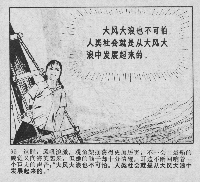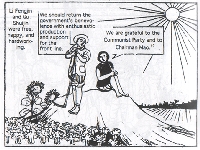 ill. 6.8, metadata
ill. 6.8, metadata
 ill. 6.9, metadata
ill. 6.9, metadata
 ill. 6.10, metadata
ill. 6.10, metadata
 ill. 6.11, metadata
ill. 6.11, metadata
 ill. 6.12 a, metadata
ill. 6.12 a, metadata
 ill. 6.12 b, metadata
ill. 6.12 b, metadata
 ill. 6.13, metadata
ill. 6.13, metadata
The Power of the Sun
Invariably, when Mao and his powerful words and thoughts are mentioned, the iconography of the radiant sun is being used: in White-Haired Girl, a comic published in 1971 and based on the model ballet by the same name, the power of the sun to make the people and their lives happy is quite evident in the final tableau, as everybody’s hands are held up to the sky and the beaming sun, in victory pose and their open smiles reveal happy determined faces (ill. 6.8). The text reinforces the message again: the people in the picture “move forward victoriously forever and ever, according to the instructions of the Great Red Flag of invincible Mao Zedong Thought” (在战无不胜的毛泽东思想下伟大红旗指引下永远胜利向前进).
Similarly, in the story of Mao’s good student and model cadre Jiao Yulu 焦裕禄 (1922–64), the halo around the book containing Mao’s words is dramatically put into scene by use of the dark background in which it is set. The text again repeats the visual impression, reconfirming that the brightness coming from Mao’s words is what makes everyone strong (ill. 6.9).
It is moments of greatest dramatic impact in these stories, and the moments of enlightenment, that call for the appearance of the sun and its powerful rays. In the 1973 comic Luo Shengjiao, which relates the story of a young soldier, Luo, who loses his life saving a Korean child from drowning in 1952, the martyr is depicted at the decisive moment: he knows he will have to sacrifice himself and is encouraged by the words of Mao and the red sun shining upon him (ill. 6.10). Indeed, the sun itself is talking to him, in the words of Mao!
In Sea Heroine (海英 Haiying), a comic published in 1975, a very similar mechanism is at work: a sent-down youth is seen here in a moment of desperation in her fight against the creepy Chen Wulao 陈乌佬, who is crow-like not just by name and who is trying to sabotage her efforts to get a good fishing harvest (ill. 6.11). Haiying is inspired by Mao’s powerful words: “Even great storms are nothing to be dreaded. It is in the midst of great storms that human society moves forward” (大风大浪也不可怕. 人类社会就是从大风大浪中发展起来的) (Mao 1957, 387). She understands that difficulties are there to be overcome. Mao’s words, from a conference on propaganda work held on March 12, 1957, are, so says the text, like the sun to her (and this is visualized in the image as they appear in a balloon that really is the sun); they warm her heart and enable her to make a spectacular catch.
This type of depiction was powerful in comic rhetoric, and it could be seen before and even after the end of the Cultural Revolution, as in a number of 1950s comics (ill. 6.12a&b) or in the 1977 comic on “iron-man” Wang Jinxi, the famous labor hero who started and brought to success Chinese oil production in Daqing (ill. 6.13). Wherever Mao and his thoughts are remembered in comics during before, and after the Cultural Revolution, the sun-like radiance appears and repels all evil.


















































































